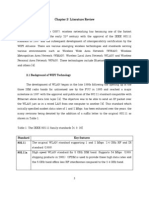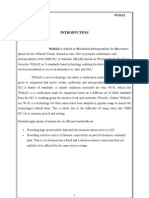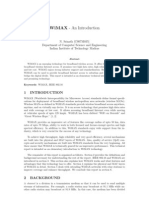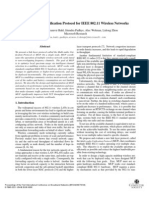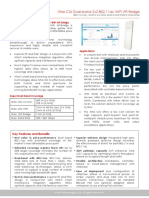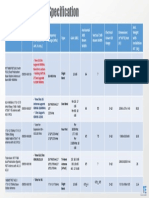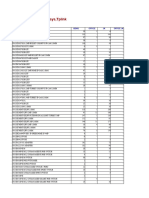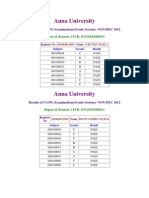0 ratings0% found this document useful (0 votes)
5 viewsITC Project
ITC Project
Uploaded by
tiwari.anjali20242026Copyright:
© All Rights Reserved
Available Formats
Download as PPTX, PDF, TXT or read online from Scribd
ITC Project
ITC Project
Uploaded by
tiwari.anjali202420260 ratings0% found this document useful (0 votes)
5 views19 pagesOriginal Title
ITC Project PPT (1)
Copyright
© © All Rights Reserved
Available Formats
PPTX, PDF, TXT or read online from Scribd
Share this document
Did you find this document useful?
Is this content inappropriate?
Copyright:
© All Rights Reserved
Available Formats
Download as PPTX, PDF, TXT or read online from Scribd
Download as pptx, pdf, or txt
0 ratings0% found this document useful (0 votes)
5 views19 pagesITC Project
ITC Project
Uploaded by
tiwari.anjali20242026Copyright:
© All Rights Reserved
Available Formats
Download as PPTX, PDF, TXT or read online from Scribd
Download as pptx, pdf, or txt
You are on page 1of 19
MULTI-LINK
OPERATION IN WIFI-7
ADITI JAISWAL - 20BEC1088
ANJALI TIWARI - 20BEC1177
K T ANKITHA- 20BEC1035
Introduction
WiFi has become widely used because of its constant improvement through periodic
revisions that enable it to adapt to the changing needs of wireless connectivity
Multi-link Operation is a crucial feature of Wi-Fi 7
MLO allows data to be transmitted and received simultaneously over several
wireless interfaces in access points and stations that have dual- or tri-band capability
In the first section of the project, we send packets across a single channel between
an AP and a station, increasing the amount of packets each time and adjusting the
SNR to demonstrate the effect on throughput and bit error rate
After that, an attempt is made to implement MLO on IEEE 802.11be WLANs by
generating a MAC frame and adding two identifying bits—which function as TID
bits—at the start of the payload
By gaining access to the TID, packets are divided into groups according to the QoS
requirements and then sent via channels 2.4, 5 or 6 GHz
By comparing the resulting throughput and transmission time with those obtained
without the use of MLO, it is possible to draw conclusions about how MLO lowers
latency and increases communication speeds
WiFi 7
IEEE 802.11be Extremely High Throughput , commonly known as WiFi 7, is the
next generation of WiFi standards
Utilising all three bands allows it to make the most of available bandwidth
WiFi 7 aims to give incredible speeds for every device with higher efficiency
than WiFi 6, which was developed in response to the world's expanding number
of gadgets
WiFi 7 offers rates that are 4.8 times faster than WiFi 6 and 13 times faster than
WiFi 5, thanks to the introduction of 320 MHz ultra-wide bandwidth, 4096-
QAM, Multi-RU, and Multi-Link Operation
WiFi 6 severely restricts the flexibility of spectrum resource scheduling because
each user can only send and receive frames on a designated resource unit
Multi-Link Operation in Wi-
Fi 7
Multi-band and multi-channel are referred to as multi-link
operations in 802.11be
The idea that a single client device can simultaneously
communicate with an AP over numerous radios and frequency
bands is introduced by Wi-Fi 7's multi-link operation
These radios can choose to operate on the 2.4, 5 or 6 GHz band,
or even just one frequency band, depending on which one
happens to be the most effective at the moment of transmission
SLO : This mode allows access to
SLO : This mode allows access to the
the primary channel interface only
primary channel interface only
MLO Modes
MLO-STR : Dual radio interface
MLO-STR : Dual radio interface
links function separately and
links function separately and
asynchronously in this mode
asynchronously in this mode
MLO-NSTR : NSTR is not capable
MLO-NSTR : NSTR is not capable
of sending and receiving data
of sending and receiving data
concurrently over separate lines
concurrently over separate lines
MLO Architecture
The MLO architecture is implemented using several
partition layouts
The MAC sub-layer is separated into Upper MAC
and Lower MAC , as shown
LMAC is a separate component for every interface
that uses its own set of parameters to carry out link-
specific operations like channel access
The MLO Concept
In previous WiFi generations, including WiFi 6 and WiFi 5, a
device can only connect to one WiFi band — either the 2.4
GHz band or 5 GHz band. The latest WiFi 6E products now
also connect to 6 GHz.
With MLO, WiFi 7 supports establishing multiple links
between the Station (STA, such as your phone) and WiFi
access point (AP, such as your router). Connecting to the 2.4
GHz, 5 GHz, and 6 GHz bands simultaneously increases
throughput, reduces latency, and improves reliability. It is
ideal for emerging applications like VR/AR, online gaming,
remote office, and cloud computing.
Packet-level aggregation in MLO
Flow-level aggregation in MLO
Approach
• The transmission of packets via a single AP to a station was carried out
and the throughput was calculated for various SNR levels
• The MAC layer was accessed and divided into upper and lower MAC
frames
• 2 bits were added to the payload contained in the lower MAC layer
• Depending on these bits the selection of 2.5, 5 and 6 GHz was made
• The comparison of the throughput for with and without MLO was
carried out
Analysis
Variation of Throughput
(packets sent through per
second) with the SNR
Variation of Packet
Error Rate (PER) with
the SNR
Variation in throughput and
PER with increasing SNR and
no. of packets
Results after MLO implementation -
Comparison of transmission time when different
frequency links are active
Throughput and transmission time
comparison - with and without MLO
Impact of MLO on throughput as
the number of users (and hence,
packets) increases.
Conclusion
The graph indicates that the implementation of
MLO helps in increasing the throughput and
decreasing latency
The transmission times with and without MLO are
depicted and a significant difference is observed
References
• Á. López-Raventós and B. Bellalta, "Multi-Link Operation in IEEE 802.11be
WLANs," in IEEE Wireless Communications, vol. 29, no. 4, pp. 94-100, August
2022, doi: 10.1109/MWC.006.2100404.
• Mediatek, “Wi-Fi 7 Multi Link Operation” , white paper, 2022.
• C. Chen, X. Chen, D. Das, D. Akhmetov and C. Cordeiro, "Overview and
Performance Evaluation of Wi-Fi 7," in IEEE Communications Standards Magazine,
vol. 6, no. 2, pp. 12-18, June 2022, doi: 10.1109/MCOMSTD.0001.2100082.
• Dr. A. Shaji George, A. S. Hovan George, & Dr. T. Baskar. (2023). Wi-Fi 7: The Next
Frontier in Wireless Connectivity. Partners Universal International Innovation
Journal, 1(4), 133–145.
• D. Medda, A. Iossifides and P. Chatzimisios, "Study of Band Allocation Policies in
IEEE 802.11be Networks with Devices of Different Capabilities," ICC 2023 - IEEE
International Conference on Communications, Rome, Italy, 2023, pp. 3205-3209, doi:
10.1109/ICC45041.2023.10279426.
• N. Korolev, I. Levitsky and E. Khorov, "Analytical Model of Multi-Link Operation in
Saturated Heterogeneous Wi-Fi 7 Networks," in IEEE Wireless Communications
Letters, vol. 11, no. 12, pp. 2546-2549, Dec. 2022, doi: 10.1109/LWC.2022.3207946.
• M. Carrascosa, G. Geraci, E. Knightly and B. Bellalta, "An Experimental Study of
Latency for IEEE 802.11be Multi-link Operation," ICC 2022 - IEEE International
Conference on Communications, Seoul, Korea, Republic of, 2022, pp. 2507-2512,
doi: 10.1109/ICC45855.2022.9838765.
You might also like
- ITC ProjectDocument19 pagesITC Projecttiwari.anjali20242026No ratings yet
- Case Study ReportDocument9 pagesCase Study ReportWatani LyNo ratings yet
- Performance Evaluation of WiFi and WiMax Using OpnetDocument9 pagesPerformance Evaluation of WiFi and WiMax Using OpnetDhanush JayaramNo ratings yet
- I Jcs It 20140504104Document5 pagesI Jcs It 20140504104Nabil MesbahiNo ratings yet
- Performance Analysis of Wimax Systems For Zigzag-Coded Modulation SchemeDocument8 pagesPerformance Analysis of Wimax Systems For Zigzag-Coded Modulation SchemeMuh Fauzi NatsirNo ratings yet
- P E E Vlan W N U Opnet M: Erformance Valuation and Nhancement of VIA Ireless Etworks Sing OdelerDocument16 pagesP E E Vlan W N U Opnet M: Erformance Valuation and Nhancement of VIA Ireless Etworks Sing OdelerALANNo ratings yet
- ICC 2008 JeremyDocument5 pagesICC 2008 JeremySubha RameshNo ratings yet
- AbstractDocument9 pagesAbstractMeganathan RamasamyNo ratings yet
- Literature ReviewDocument22 pagesLiterature ReviewAmy Kueh100% (1)
- Wimax Is Defined As Worldwide Interoperability For Microwave Access by The Wimax Forum, Formed in June 2001 To Promote Conformance andDocument13 pagesWimax Is Defined As Worldwide Interoperability For Microwave Access by The Wimax Forum, Formed in June 2001 To Promote Conformance andSoorej KamalNo ratings yet
- Rajesh WiFiDocument7 pagesRajesh WiFiappukumaranNo ratings yet
- Wimax and The Concept of ImplementationDocument29 pagesWimax and The Concept of ImplementationRajanMiglani396No ratings yet
- Wimax - An IntroductionDocument10 pagesWimax - An IntroductionDeepak KandaNo ratings yet
- 13 Performance EvaluationDocument7 pages13 Performance EvaluationMalebogo BabutsiNo ratings yet
- "Wimax": Emerging Wireless TechnologyDocument12 pages"Wimax": Emerging Wireless Technologyapi-20008301No ratings yet
- Wi-Max Physical Layer Simulator Using Different Modulation SchemesDocument7 pagesWi-Max Physical Layer Simulator Using Different Modulation SchemesInternational Journal of computational Engineering research (IJCER)No ratings yet
- Airberry Whitepaper en 02 Wireless MeshDocument8 pagesAirberry Whitepaper en 02 Wireless MeshpokechoNo ratings yet
- 4.4 An Introduction To Wifi: Section 3.3Document8 pages4.4 An Introduction To Wifi: Section 3.3Geofrey KemboiNo ratings yet
- WLAN - 802.11 A, B, G and N: Wireless Standards White Paper SeriesDocument10 pagesWLAN - 802.11 A, B, G and N: Wireless Standards White Paper Seriessidsharma187No ratings yet
- Spectrum, Significantly Reduces The Possibility of Outward and Inward Interference. As A Result, Regulatory BodiesDocument10 pagesSpectrum, Significantly Reduces The Possibility of Outward and Inward Interference. As A Result, Regulatory BodiesthomasalvatranNo ratings yet
- WIFI7Document24 pagesWIFI7allbinthankachan5492No ratings yet
- Wi MAXDocument37 pagesWi MAXA N JayanthiNo ratings yet
- WiMAX: Final Destination or PathDocument7 pagesWiMAX: Final Destination or Pathharjitsingh198No ratings yet
- Bluetooth, Zigbee, Wi-Fi: Comparative Study Wireless Protocols: andDocument6 pagesBluetooth, Zigbee, Wi-Fi: Comparative Study Wireless Protocols: andRafael Grueso CarabaliNo ratings yet
- Bluetooth, Zigbee, Wi-Fi: Comparative Study Wireless Protocols: andDocument6 pagesBluetooth, Zigbee, Wi-Fi: Comparative Study Wireless Protocols: andbandokkhanNo ratings yet
- Mobile ComputingDocument16 pagesMobile ComputingAbir ChowdhuryNo ratings yet
- Simulation and Performance Analysis of AODV, OLSRDocument8 pagesSimulation and Performance Analysis of AODV, OLSRNguyen Danh DongNo ratings yet
- Communication Systems: Lab 3 AssignmentDocument9 pagesCommunication Systems: Lab 3 AssignmentAbdelrahman Abdelsalam Fathy100% (1)
- Module 4Document30 pagesModule 4Ananya LokeshNo ratings yet
- MeshDocument28 pagesMeshpkmehan1983No ratings yet
- 1.1 Evolution of Low-Rate Wireless Personal Area Network (LR-WPAN) StandardizationDocument29 pages1.1 Evolution of Low-Rate Wireless Personal Area Network (LR-WPAN) StandardizationAnonymous 9B0VdTWiNo ratings yet
- Performance Evaluation For Wi Fi Offload-1Document10 pagesPerformance Evaluation For Wi Fi Offload-1julien PELENo ratings yet
- المعيارDocument3 pagesالمعيارabdullah2001ali3No ratings yet
- Paper 2Document17 pagesPaper 2dhipaaneshNo ratings yet
- Wimax AbstractDocument6 pagesWimax AbstractMaqsood UldeNo ratings yet
- What Is Wimax?: Standards Associated To WimaxDocument20 pagesWhat Is Wimax?: Standards Associated To WimaxSujith KallingalNo ratings yet
- Investigate The Effect of Different Mobility Trajectory On VOD Over WIMAXDocument7 pagesInvestigate The Effect of Different Mobility Trajectory On VOD Over WIMAXIOSRjournalNo ratings yet
- Simulation of Coverage of WimaxDocument8 pagesSimulation of Coverage of Wimaxعبدالله أبورويصNo ratings yet
- Iot Project ReportDocument94 pagesIot Project Reportmadhan_M46No ratings yet
- Wimax (802.16) : A Road To Mobile LifeDocument20 pagesWimax (802.16) : A Road To Mobile LifeVenu Gopal PNo ratings yet
- Simulation of Physical Layer of Wimax Network Using Opnet ModellerDocument4 pagesSimulation of Physical Layer of Wimax Network Using Opnet ModellerWaqas MoazzamNo ratings yet
- module IV.Document49 pagesmodule IV.Ott ApkNo ratings yet
- 802 11axDocument10 pages802 11axtien nguyenNo ratings yet
- Detecting Node Failures in Mobile Wireless Networks: A Probabilistic ApproachDocument15 pagesDetecting Node Failures in Mobile Wireless Networks: A Probabilistic ApproachGateway ManagerNo ratings yet
- Wimax For DummiesDocument35 pagesWimax For DummiesMichael John MjattaNo ratings yet
- Zigbee TechnologyDocument32 pagesZigbee Technologyminigun100% (4)
- Wimax System Performance StudiesDocument10 pagesWimax System Performance StudiesFelix GatambiaNo ratings yet
- (1a) The-Wi-Fi-Evolution-White-PaperDocument6 pages(1a) The-Wi-Fi-Evolution-White-PaperultrahornytgtNo ratings yet
- 21EC1929 Wireless Networks Question BankDocument46 pages21EC1929 Wireless Networks Question BankASHOK RNo ratings yet
- Design and Implementation of WIFI MAC Transmitter For Low Power ApplicationsDocument8 pagesDesign and Implementation of WIFI MAC Transmitter For Low Power ApplicationsPadma RatnaNo ratings yet
- ZigBee_ThroughputDocument13 pagesZigBee_ThroughputThư TrầnNo ratings yet
- 6LoWPAN PDFDocument13 pages6LoWPAN PDFozmeenNo ratings yet
- WiMAX PDFDocument13 pagesWiMAX PDFClovis MolarNo ratings yet
- 2009 New Presentation On WimaxDocument68 pages2009 New Presentation On WimaxHarazneh Abu HazemNo ratings yet
- A Multi-Radio Unification Protocol For IEEE 802.11 Wireless NetworksDocument11 pagesA Multi-Radio Unification Protocol For IEEE 802.11 Wireless NetworksAjinkya KaleNo ratings yet
- Verilog Based Design and Simulation of MAC and PHY Layers For Zigbee Digital TransmitterDocument9 pagesVerilog Based Design and Simulation of MAC and PHY Layers For Zigbee Digital TransmitterZoro ZoroNo ratings yet
- CompTIA Network+ (N10-009) Study Guide: Comprehensive Exam Preparation and Key Concepts for Network ProfessionalsFrom EverandCompTIA Network+ (N10-009) Study Guide: Comprehensive Exam Preparation and Key Concepts for Network ProfessionalsNo ratings yet
- Cisco Certified Network Associate (CCNA) and Cisco Certified Network Professional (CCNP): Mastering Network Automation and Programmability Study GuideFrom EverandCisco Certified Network Associate (CCNA) and Cisco Certified Network Professional (CCNP): Mastering Network Automation and Programmability Study GuideNo ratings yet
- Lab 1Document5 pagesLab 1tiwari.anjali20242026No ratings yet
- Ece3003 Group 2 Final ReviewDocument19 pagesEce3003 Group 2 Final Reviewtiwari.anjali20242026No ratings yet
- Itc Da 2 20bec1177Document9 pagesItc Da 2 20bec1177tiwari.anjali20242026No ratings yet
- Services MarketingDocument33 pagesServices Marketingtiwari.anjali20242026No ratings yet
- Coordinator - Ganesh DharDocument17 pagesCoordinator - Ganesh DharsubhamaybiswasNo ratings yet
- TUGAS Sensor DHT INFLUXDB - GRAFANADocument5 pagesTUGAS Sensor DHT INFLUXDB - GRAFANApramudya.wardhana86No ratings yet
- MCC - ModificationDocument45 pagesMCC - Modificationkahkashan SiddavatamNo ratings yet
- DAP 1360 B1 Manual V2 00 EUDocument98 pagesDAP 1360 B1 Manual V2 00 EUVishwa NathanNo ratings yet
- Fix Network Issue Juni Dan Juni 2023Document107 pagesFix Network Issue Juni Dan Juni 2023Moh Dwi SalindriNo ratings yet
- PLDT Prolinkwifirepeater Quickstartguide PDFDocument2 pagesPLDT Prolinkwifirepeater Quickstartguide PDFLenin KingNo ratings yet
- Huawei E5788u 96a Mobile Wifi Specs DatasheetDocument22 pagesHuawei E5788u 96a Mobile Wifi Specs Datasheetasiong chenNo ratings yet
- IEEE Standard 802.16 For Global Broadband Wireless AccessDocument33 pagesIEEE Standard 802.16 For Global Broadband Wireless Accesswork067No ratings yet
- 4G Aggregate HourlyDocument310 pages4G Aggregate Hourlywardana_kusuma4493No ratings yet
- Datasheet - EAP610-Outdoor V1Document6 pagesDatasheet - EAP610-Outdoor V1Ricardo Gilmore GonzalezNo ratings yet
- Altai C2s Catalog Eng 170224Document2 pagesAltai C2s Catalog Eng 170224glocallNo ratings yet
- NCR N301 A - EngDocument2 pagesNCR N301 A - EngMario MoroNo ratings yet
- CH 14Document34 pagesCH 14Alone Mast100% (1)
- Antenna Data SpecsDocument1 pageAntenna Data Specstamoor raoNo ratings yet
- Blutooth PPT 4th AttemptDocument25 pagesBlutooth PPT 4th AttemptMd RehanNo ratings yet
- Contoh Descriptive Text Tentang WifiDocument1 pageContoh Descriptive Text Tentang WifiJess100% (2)
- 802.11 Disassociation Deauthentication and ReassociationDocument9 pages802.11 Disassociation Deauthentication and Reassociationabhishek4vishwakar-1No ratings yet
- Stock Hikvision, Mercusys, Tplink Rev. 240524Document6 pagesStock Hikvision, Mercusys, Tplink Rev. 240524rachman.dreadoutNo ratings yet
- If6i-Wmn-Unit 2 NotesDocument18 pagesIf6i-Wmn-Unit 2 Notes514 Vaibhavi PawarNo ratings yet
- WSN Ece B Lesson PlanDocument6 pagesWSN Ece B Lesson PlanViswakarma ChakravarthyNo ratings yet
- 802.11w TutorialDocument14 pages802.11w TutorialAirTightNetworksNo ratings yet
- Hsdpa, Lte, Lte-A MCQ Part 1Document3 pagesHsdpa, Lte, Lte-A MCQ Part 1sdefmpyNo ratings yet
- Cisco 2800 Access Point DatasheetDocument11 pagesCisco 2800 Access Point DatasheetBrandon BarreraNo ratings yet
- Continue: Hack Wps Locked Wifi AndroidDocument4 pagesContinue: Hack Wps Locked Wifi Androidየዓለምዘውድ መኮንንNo ratings yet
- Symbian Virus ListDocument4 pagesSymbian Virus ListShane ParsonsNo ratings yet
- Photographs of EUTDocument32 pagesPhotographs of EUTBaron MunchausenNo ratings yet
- Exp 4Document6 pagesExp 4Dhanya SharanyaNo ratings yet
- Anna University Civil Lateral (100404815001-28)Document18 pagesAnna University Civil Lateral (100404815001-28)pddsivaNo ratings yet
- Wireless LAN PPT For Week 2Document12 pagesWireless LAN PPT For Week 2Jennifer LawsonNo ratings yet
- Specificatii Homeplug Sitecom Kit 85Mbps (Cod Produs: LN-514) Homeplug Sitecom Kit 85MbpsDocument3 pagesSpecificatii Homeplug Sitecom Kit 85Mbps (Cod Produs: LN-514) Homeplug Sitecom Kit 85MbpsAnonymous JtFc6nKNNo ratings yet









